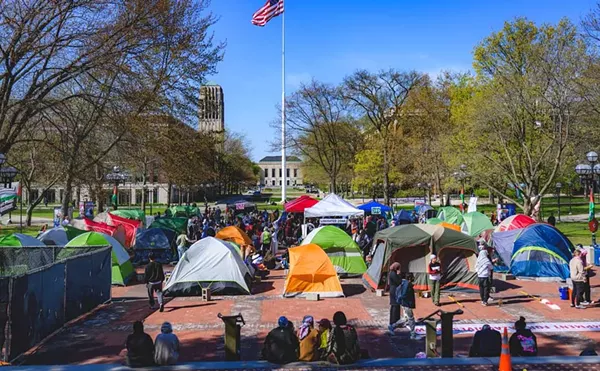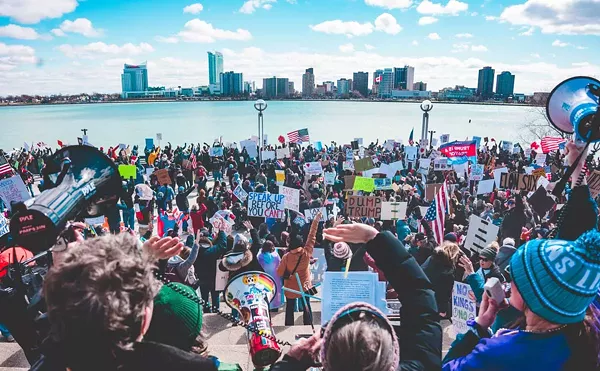
Audio By Carbonatix
[
{
"name": "GPT - Leaderboard - Inline - Content",
"component": "35519556",
"insertPoint": "5th",
"startingPoint": "3",
"requiredCountToDisplay": "3",
"maxInsertions": 100,
"adList": [
{
"adPreset": "LeaderboardInline"
}
]
}
]
Call it the arc of environmental justice.
Although its origins may be diffuse, a primary starting point can be traced to North Carolina, circa 1982, when the state opened a landfill for soil contaminated by the highly toxic compound PCB in rural Warren County. Area residents, predominantly African-American, organized in protest.
That resistance attracted the attention of the United Church of Christ (UCC). Inspired by the struggle taking place in Warren County, the UCC in 1987 released "Toxic Wastes and Race in the United States," the first national study to show a correlation between the location of hazardous waste facilities and race. Its findings that race is "the most potent variable in predicting where commercial hazardous waste facilities were located in the United States ..." served as a catalyst.
The term "environmental racism" started to become part of our political vocabulary. Academics began to study the issue in greater numbers. Activists were inspired to mobilize, leading to another landmark — the first People of Color Environmental Leadership Summit, convened in Washington, D.C., in 1991 by the UCC. With the environmental justice movement still defining itself, more than 1,000 grassroots activists worked to create a list of guiding principles.
"I was blessed to be part of that," says Donele Wilkins, now executive director of the group Detroiters Working for Environmental Justice. Having previously focused on workplace health issues, Wilkins says that attending the summit "sparked what I wanted to do with the rest of my life."
It was a heady time, recalls Kathryn Savoie, environmental program director for the Arab Community Center for Economic and Social Services (ACCESS) in Dearborn.
"Coming out of that summit, there was incredible energy and a lot of movement," says Savoie, who also participated in the historic gathering.
In 1992 the U.S. Environmental Protection Agency issued a report in which, for the first time, the federal government acknowledged that some population groups suffer greater environmental health risks than others. The following year, the EPA established the 25-member National Environmental Justice Advisory Council.
Then, in 1994, President Bill Clinton signed Executive Order 12898, which mandated that every federal agency "shall make achieving environmental justice part of its mission by identifying and addressing, as appropriate, disproportionately high and adverse human health or environmental effects of its programs, policies and activities on minority populations and low-income populations in the United States."
That order was a "high-water mark," says University of Michigan Professor Paul Mohai, an environmental sociologist in the School of Natural Resources and Environment, and one of the nation's leading experts on environmental justice issues.
That was then ...
Jump ahead to 2007. A follow-up to the original 1987 report is produced. Titled "Toxic Wastes and Races at Twenty," the new study — co-authored by Mohai with colleages Robert D. Bullard, Robin Saha and Beverly Wright — concludes, "People of color are found to be more concentrated around hazardous waste facilities than previously shown."
According to the new study — which utilizes improved methods of analysis developed over the two decades since the initial report was produced — "people of color make up the majority of those living in host neighborhoods within 3 kilometers (1.8 miles) of the nation's hazardous waste facilities. Racial and ethnic disparities are prevalent throughout the country."
The problem is particularly acute in Michigan, especially in Detroit.
The new study found that Michigan leads the nation in terms of the disparity between the percentages of people of color living within 1.8 miles of a hazardous waste facility compared to the percentage of minorities outside that radius — 66 percent versus 19 percent. In other words, more than two-thirds of the people living near these sites are people of color, while fewer than 20 percent of those living outside the 3-kilometer radii are minorities. By comparison, the national numbers are 56 percent minorities in so-called "host" communities versus 30 percent in non-host communities.
Compounding the problem here is the number of such facilities located in Detroit, which is home to 12 hazardous waste sites. Of large metropolitan areas, only Los Angeles, with 17, has more.
As the Rev. M. Linda Jaramillo of the UCC writes: "It is ironic that 20 years after the original 'Toxic Wastes and Race' report, many of our communities face not only the same problems they did back then, but now they face new ones because of government cutbacks in enforcement, weakening health protection and dismantling the environmental justice regulatory apparatus."
What happened?
There's no single answer to that question. But one key factor has been the ability of corporate America to flex its political muscle and eat away at the movement's initial progress.
"I think there was a backlash from corporations that began in the early '90s," says Savoie. "They began projecting the message that environmental justice was a job-killer."
For there to be economic progress, there had to be what came to be known as "sacrifice zones," the argument went, areas where polluting and hazardous industries would be located at the expense of local communities for the greater economic good.
Savoie sees that jobs versus the environment debate as a false dichotomy. As time goes on it is becoming more and more apparent that sustainable industry that promotes a healthy environment and healthy communities is a component of economic growth, not an impediment. Without that, the costs of long-term environmental cleanup and the health consequences of pollution create a drag on the economy.
"We're beginning to see the enormous costs of environmental damage, whether it's in terms of global warming or damage to communities," she says.
There's also a bigger picture that is coming into better focus. The idea of community being a "sacrifice zone" is fundamentally flawed, says Savoie. "There are some people who will be hurt first, and hurt the most," she explains, "but those toxins are getting into the air, the soil, the water and our bodies. Eventually, everybody begins to be affected."
There is another issue as well, says Rhonda Anderson, environmental justice organizer for the Sierra Club in Detroit. It has to do with the nature of bigotry itself.
"You don't have racism in compartments," she says. "Environmental racism is a continuation of a problem that exists in society at large."
If one group of people is considered inferior and of less consequence, then, she says, "it's just too damn easy to put a polluting industry in their community."
She points to the recent debate regarding location of a second river crossing between Detroit and Windsor. When the group studying the issue initially suggested a bridge could be located in such upscale communities as Grosse Ile and Grosse Pointe, those communities quickly mounted protests and those plans were discarded. Consequently, the focus of a new crossing is the poorer, heavily minority community of southwest Detroit.
But, as Wilkins points out, there have been some recent victories as well. Most notable was the 2004 closure of a controversial medical waste incinerator operated by Henry Ford Hospital in Detroit. Another medical waste incinerator, after heavy pressure was brought to bear by community activists in Hamtramck, was shut down by the state last year.
Mohai, who describes himself as a glass-half-full kind of guy, sees hope in last year's congressional elections, and the fact that key committees are now chaired by Democrats "more sympathetic" to the issue than their Republican predecessors.
Moreover, the new report he helped produce could — as the one 20 years ago did — put a spotlight on the issue and create renewed momentum.
Despite the stalled progress, Savoie and Wilkins are buoyed by the fact that, even though the number of minority communities being affected by polluters remains excessive, the movement itself has continued to grow.
Twenty years ago, the term "environmental justice" was alien to most people. Now, it is part of our vocabulary, and that in itself is a major step forward.
"People now know what we are talking about," says Wilkins. "People on a policy level are aware of the issue. Things are incrementally changing, and we've made small steps forward, and we are poised to grow more."
And that knowledge is crucial. Change is attainable, but it won't come easily. It will take effort and organization and community commitment.
"This really needs to be said," insists Wilkins. "We're not just victims at this table. And the more people know, the more able we are to fight these things."
Read the report: "Toxic Wastes and Races at Twenty" (PDF format)
Curt Guyette is Metro Times news editor. Contact him at 313-202-8004 or cguyette@metrotimes.com




